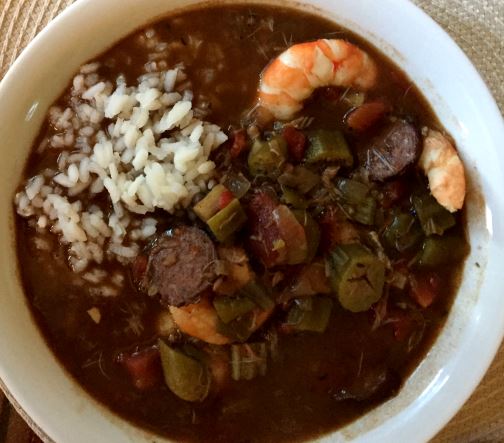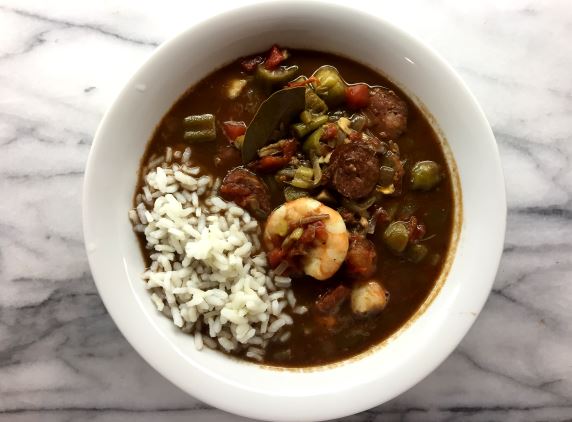The Southern Spread

by deborah fagan carpenter
Our culture, our history, our spirit, and our hospitality are some of the ingredients. Southern foods are heavily influenced by African, English, Scottish, Irish, French, and Native-American cuisine, and although most of them are served across the country today, there are foods in the U.S. that are strictly thought of as SOUTHERN. There’s Creole, Lowcountry, and Floribbean, and I’m not sure where fried chicken and deviled eggs fit into the mix, but to be certain, they perform with a southern accent. In “The Southern Spread,” we’re exploring southern foods and traditions.
With political divisiveness hovering over us like an enormous, thunder-clap about to rumble, a lot of people — myself included — have been uncontrollably embroiled in outrage, incredulity, alarm, and disillusionment. But, for today, at least, I’ve made the decision to “accept the things I cannot change”— AND MAKE GUMBO.
The state of Louisiana is as unique a place as there is in the country, and it can safely boast having the most distinct, exotic, and delicious food in the country — possibly the world. With all there is to choose from, one of its most renowned and respected culinary creations, also the official state cuisine, is gumbo.

“The great dish of New Orleans, and which it claims having the honor of invented, is the GUMBO. There is no dish which at the same time so tickles the palate, satisfies the appetite, furnishes the body with nutriment sufficient to carry on the physical requirements, and costs so little as a Creole Gumbo. It is a dinner in itself, being soup, piece de résistance, entremet and vegetable in one. Healthy, and not heating to the stomach and easy of digestion, it should grace every table.”
William H. Coleman, ‘Historical Sketch Book and Guide to New Orleans and Environs’ (1985)
Gumbo is a soup made with either meat or shellfish and “the holy trinity,” which is a combination of onions, celery, and bell pepper, and it’s thickened with either okra or filé powder — dried, ground sassafras leaves. (The African Bantu word for okra is (ki)ngombo, and the Choctaw word for filé is kombo, which are possibilities for the origin of the name gumbo.) Whatever the choice of thickening agent or whatever the choice of basic ingredients for gumbo, before any of them are added to the pot, “first, you make a roux.”
Roux is made by cooking equal parts of either butter or oil and flour over relatively high heat until it reaches the desired color for whatever dish it’s being prepared. Roux for gumbo is as dark as the cook can arrive at without burning it, and with its rich, nutty flavor, it’s absolutely essential as the foundation of the soup. Unless the cook is an experienced chef, it’s best cooked over medium heat, stirring constantly for about thirty minutes. Extreme caution is advised while preparing it to avoid burning oneself, and if the roux itself burns at all, throw it away and start over. When the roux becomes a dark, chocolate-brown, remove it from the heat source and add the chopped vegetable trio to it to slow the cooking, then return it to the heat and let the vegetables sauté until they’re slightly softened.
My Mother, Annie Fagan, played the organ at the J.J. White Memorial Presbyterian Church in McComb, Mississippi for 25 or 30 years, worked at Gillis’s Drug Store as the clerk who took customer’s payments for their prescriptions, cosmetics, or soda fountain charges, and, she made outstanding gumbo. Her recipe was given to her by a friend in New Orleans, and while I recognize that everybody has their own particular gumbo recipe which they consider the best, her’s is a pretty good one, and naturally, the one I love the most.
“Oh, I never order gumbo when I go out. I already know that mine’s the best.”
Housewife, Vermillion Parish, Louisiana
Living in South Mississippi, it was easy to buy fresh shrimp and whole blue crabs, so that was what Mother used, rather than chicken or other foul, and her “holy trinity” was actually a “happy duo” of only onions and garlic. She never added Andouille sausage to it, but it’s something I almost always use, and my “holy trinity” is onions, garlic, and celery. I add the slices of sausage to the hot roux at the same time I add the vegetables. Cajun gumbo doesn’t include tomatoes, but Creole gumbo does so Mother’s would fall into that category. Mother used bacon grease as her source of oil, which, of course, would be heavily frowned upon in today’s health-conscious world, but boy, does it add a scrumptious layer of flavor. Below is Mother’s recipe for gumbo.
Forgive this personal indulgence:
October’s feature on The Southern Spread:
Annie Fagan’s Gumbo

Annie Fagan’s Gumbo
Equal parts flour and bacon grease, or oil of choice
1 large onion, (chopped); Several stalks of celery, (chopped) (Annie didn’t put this); Garlic, (Finely chopped) (5 or 6 cloves); Andouille sausage, (sliced); Okra, (sliced), (a couple of cups); Diced tomatoes, (One large can or the equivalent of fresh); Rather than plain water, use shrimp stock, crab stock, chicken stock, or even beef stock. Anything other than plain water. (An easy shrimp stock can be made with the shrimp shells you’ve gotten after peeling the ones for the recipe. If you buy shrimp with the heads on, they’re perfect for making the stock). 1 ½ teaspoons thyme; A teaspoon or half a teaspoon of Allspice; Salt and pepper to taste; Bay leaves, (3 or 4); I bag of Zatarain’s shrimp/crab boil. (remove after about 30 minutes) If you can only locate powdered Zatarain’s, use it to taste, but cautiously, as it has quite a kick. Shrimp, (1 pound peeled); Blue crabs, (broken in half) or claw crab meat (1 pound) (It’s sweeter than lump)
Make the roux with bacon grease or oil of choice. Remove it from heat when the roux is really, really dark and add the chopped vegetables and the sausage. Return it to the heat source and sauté until the vegetables are slightly softened and then add the tomatoes, okra, and all the seasonings. Add the crabs or crabmeat, but don’t put the shrimp in until shortly before serving. If you don’t have shrimp stock, put a few in at the beginning of the simmering process for flavor. Simmer for a couple of hours. As with many soups, stews, or sauces, it’s even better the second day after the flavors have “married.”



I can’t wait to try this Deborah now trying to figure out how to print the recipe
Martha, just highlight it and copy it to your computer. Let me know if I can help
I never had your mom’s gumbo but I will now! Thanks for sharing!
Thanks, Kay!
When I saw the recipe this morning it made my mouth water.
It was worth writing the article to make myself cook a pot of it, Nell. I do love it.
This sounds delicious! The photo is mouth watering too… even at 6:45 in the morning. Thank you for another great article. G
Thanks for reading, G!